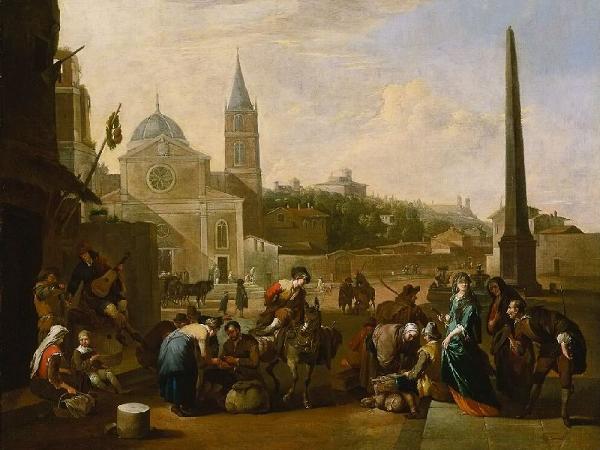
Bamboccianti. The Bamboccianti were genre painters active in Rome from about 1625 until the end of the seventeenth century.
Most were Dutch and Flemish artists who brought existing traditions of depicting peasant subjects from sixteenth-century Netherlandish art with them to Italy, and generally created small cabinet paintings or etchings of the everyday life of the lower classes in Rome and its countryside. Typical subjects include food and beverage sellers, farmers and milkmaids at work, soldiers at rest and play, and beggars, or, as Salvator Rosa lamented in the mid-seventeenth century, rogues, cheats, pickpockets, bands of drunks and gluttons, scabby tobacconists, barbers, and other 'sordid' subjects.
Despite their lowly subject matter, the works found appreciation among elite collectors and fetched high prices. Many of the artists associated with the Bamboccianti were members of the Bentvueghels, an informal association of mainly Dutch and Flemish artists in Rome.
It was customary for the Bentvueghels to adopt an appealing nickname, the so-called 'bent name'. The bent name of the Dutch painter Pieter van Laer was Il Bamboccio, which means ugly doll or puppet.
This was an allusion to van Laer's ungainly proportions. Van Laer is regarded as the initiator of the Bamboccianti style of genre painting and his nickname gave the genre and the group of artists its collective name. He became the
Most were Dutch and Flemish artists who brought existing traditions of depicting peasant subjects from sixteenth-century Netherlandish art with them to Italy, and generally created small cabinet paintings or etchings of the everyday life of the lower classes in Rome and its countryside. Typical subjects include food and beverage sellers, farmers and milkmaids at work, soldiers at rest and play, and beggars, or, as Salvator Rosa lamented in the mid-seventeenth century, rogues, cheats, pickpockets, bands of drunks and gluttons, scabby tobacconists, barbers, and other 'sordid' subjects.
Despite their lowly subject matter, the works found appreciation among elite collectors and fetched high prices. Many of the artists associated with the Bamboccianti were members of the Bentvueghels, an informal association of mainly Dutch and Flemish artists in Rome.
It was customary for the Bentvueghels to adopt an appealing nickname, the so-called 'bent name'. The bent name of the Dutch painter Pieter van Laer was Il Bamboccio, which means ugly doll or puppet.
This was an allusion to van Laer's ungainly proportions. Van Laer is regarded as the initiator of the Bamboccianti style of genre painting and his nickname gave the genre and the group of artists its collective name. He became the
Wikipedia ...